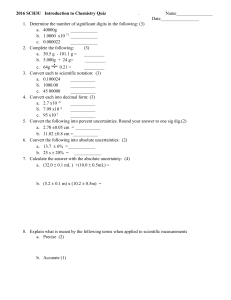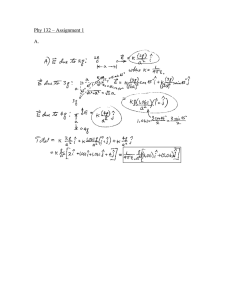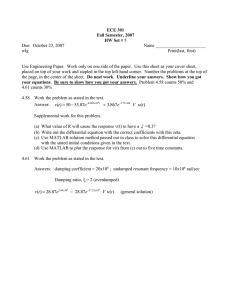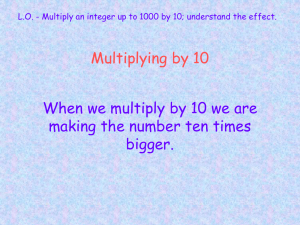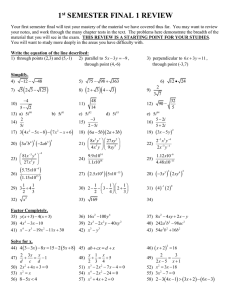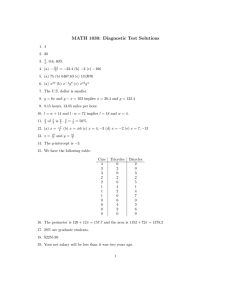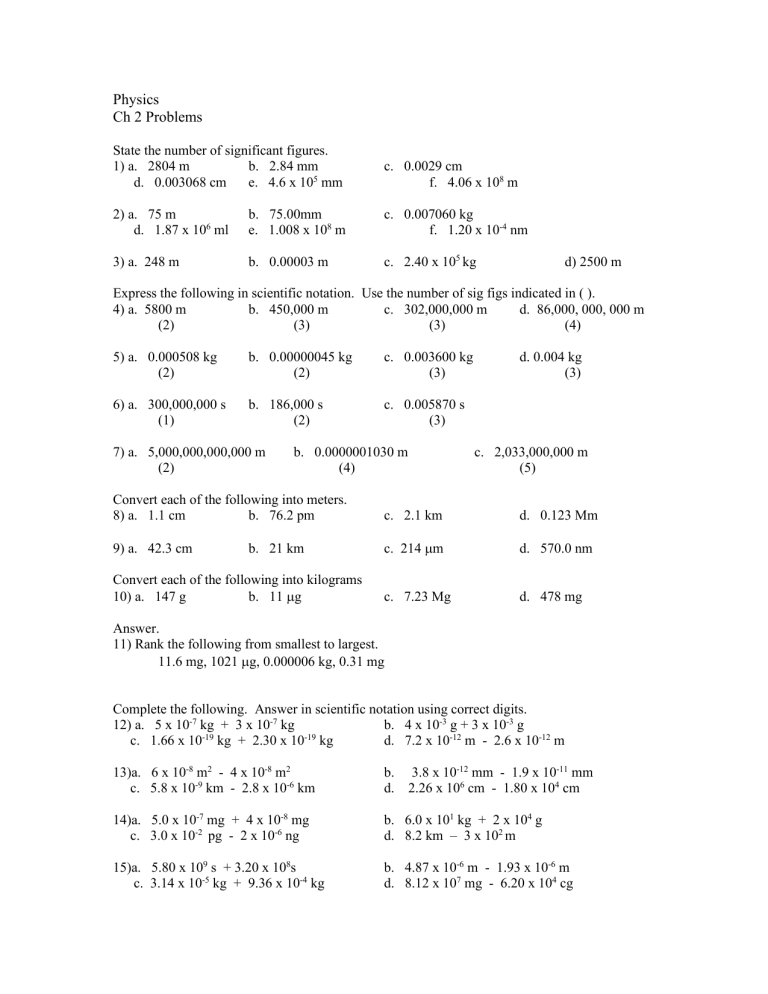
Physics Ch 2 Problems State the number of significant figures. 1) a. 2804 m b. 2.84 mm d. 0.003068 cm e. 4.6 x 105 mm c. 0.0029 cm f. 4.06 x 108 m 2) a. 75 m d. 1.87 x 106 ml b. 75.00mm e. 1.008 x 108 m c. 0.007060 kg f. 1.20 x 10-4 nm 3) a. 248 m b. 0.00003 m c. 2.40 x 105 kg d) 2500 m Express the following in scientific notation. Use the number of sig figs indicated in ( ). 4) a. 5800 m b. 450,000 m c. 302,000,000 m d. 86,000, 000, 000 m (2) (3) (3) (4) 5) a. 0.000508 kg (2) b. 0.00000045 kg (2) c. 0.003600 kg (3) 6) a. 300,000,000 s (1) b. 186,000 s (2) c. 0.005870 s (3) 7) a. 5,000,000,000,000 m (2) b. 0.0000001030 m (4) d. 0.004 kg (3) c. 2,033,000,000 m (5) Convert each of the following into meters. 8) a. 1.1 cm b. 76.2 pm c. 2.1 km d. 0.123 Mm 9) a. 42.3 cm c. 214 m d. 570.0 nm c. 7.23 Mg d. 478 mg b. 21 km Convert each of the following into kilograms 10) a. 147 g b. 11 g Answer. 11) Rank the following from smallest to largest. 11.6 mg, 1021 g, 0.000006 kg, 0.31 mg Complete the following. Answer in scientific notation using correct digits. 12) a. 5 x 10-7 kg + 3 x 10-7 kg b. 4 x 10-3 g + 3 x 10-3 g -19 -19 c. 1.66 x 10 kg + 2.30 x 10 kg d. 7.2 x 10-12 m - 2.6 x 10-12 m 13)a. 6 x 10-8 m2 - 4 x 10-8 m2 c. 5.8 x 10-9 km - 2.8 x 10-6 km b. 3.8 x 10-12 mm - 1.9 x 10-11 mm d. 2.26 x 106 cm - 1.80 x 104 cm 14)a. 5.0 x 10-7 mg + 4 x 10-8 mg c. 3.0 x 10-2 pg - 2 x 10-6 ng b. 6.0 x 101 kg + 2 x 104 g d. 8.2 km – 3 x 102 m 15)a. 5.80 x 109 s + 3.20 x 108s c. 3.14 x 10-5 kg + 9.36 x 10-4 kg b. 4.87 x 10-6 m - 1.93 x 10-6 m d. 8.12 x 107 mg - 6.20 x 104 cg 16)a. (2 x 104 m)(4 x 108 m) c. (6.00 x 10-4 cm)(5.0 x 10-8 m) 17)a. 6.32 x10 8 kg 2.0 x10 4 m 2 b. b. (3 x 104 m)(2 x 106 m) d. (2.500 x 10-7 kg)(2.5000 x 1016 m) 6.57 x10 8 kg 2.27 x10 − 4 g c. 16.250 x10 −8 m 4.983 x10 − 4 s (2.5 x10 6 kg )(6.0 x10 4 m) b. 5.00 x10 − 2 s 2 (3x10 4 kg )(4 x10 4 m ) 18) a. 6 x10 4 s Complete the following using correct digits. 19) 6.201 cm + 7.4 cm + 6.8 mm + 12.0 cm 20) a. 10.8 g – 8264 mg b. 0.475 m – 4168 µm 21) a. (131 cm)(2.3 km) b. (3.214 nm)(4.23 µm) 22) a. 20.2 cm 7.41 s b. 3.1416 s2 12.40 ms 23) a. 16.2 m + 5.008 m + 13.48 m c. 15.07 kg – 12.0 kg b. 5.006 m +12.0077 dm –3.0084 m 24) a. (6.20 x 1018 m)(4.7 x 10-10 m) b. (5 x 10-7 m) ( 2.8 x 10-12 s) Convert each of the following using correct significant figures. 25) Convert 78 minutes to a) seconds b) hours 26) Convert 3.4 hours to a) minutes b) seconds 27) Convert 18.0 m/s to km/h 28) Convert 34 km/h to m/s 29) Convert 31.5 m/s to km/h 30) Use the equation y = mx+b a. solve for b b. solve for x 31) Solve the following equations for v. a. d = vt b. t = d v c. a = v2 2d 32) Solve the following equations for E. a. f = E s b. m = 2E v2 c. E +k =m c2 d. v b = a c 33) Solve v2 = h2 + 2ad for d. 34) Solve each equation for a. a. v = h + at d. v = b. y = ht + 1 2 at 2 c. v2 = h2 + 2ay 2as 35) Find the area of a rectangle with sides 2.0 mm and 30.0 cm. 36) Find the perimeter of a rectangle with sides 25 cm and 2.00 m. 37) A rectangular floor that is to be carpeted has a length of 15.72 m and a width of 4.40 m. Calculate the area that will be covered by carpet. 38) A yard is 33.21 m long and 17.6 m wide. a. What length of fence needs to be purchased to enclose the entire yard? b. What area must be covered if the entire yard is to be fertilized? 39) A water tank has a mass of 3.64 kg when empty and a mass of 51.8 kg when full. What is the mass of the water in the full tank? 40) Using the equation v = d find the answers to the following. (v = speed, d = distance, t = t time) a. Find the distance a bike travels in 1.5 hours if it’s traveling 21 km/h. b. How long will it take to travel 6.0 km if it is moving at 30.0 km/h? 41) The following data was collected during an experiment. Volume Mass (g) (cm3) 10.0 7.9 20.0 15.8 30.0 23.7 40.0 31.6 50.0 39.6 a. Plot the points b. Determine what type of curve fits best c. Calculate the best fit line and graph 42) The following data was collected during an experiment. Accel (m/s2) Force (N) 5.0 4.9 10.0 9.8 15.0 15.2 20.0 20.1 25.0 25.0 30.0 29.9 a. Plot the points b. Determine what type of curve fits best c. Calculate the best fit line and graph 43) The following data was collected during an experiment. Time Distance (m) (s) 1.0 5.0 2.0 20.0 3.0 44.0 4.0 78.0 5.0 123.0 a. Plot the points b. Determine what type of curve fits best c. Calculate the best fit line and graph Ch 2 Solutions 1) 4 b) 3 c) 2 d) 4 e) 2 f) 3 2) 2 b) 4 c) 4 d) 3 e) 4 f) 3 3) 3 b) 1 c) 3 d) unknown 4) 5.8 x 103 m b) 4.50 x 105 m c) 3.02 x 108 m d) 8.600 x 1010 m -4 -7 -3 5) 5.1 x 10 kg b) 4.5x 10 kg c) 3.60 x 10 kg d) 4.00 x 10-3 kg 8 5 -3 6) 3 x 10 s b) 1.9 x 10 s c) 5.87 x 10 s 12 -7 7) 5.0 x 10 m b) 1.030 x 10 m c) 2.0330 x 109 m 8) 0.011m b)0.0000000000762m c)2.1 x 103 m d) 1.23 x 105 m 4 9) 0.423 m b) 2.1 x 10 m c) 0.000214 m d) 0.0000005700 m 10) 0.147 m b) 0.000000011 kg c) 7.23 x 103 kg d) 0.000478 kg 11) 0.31 mg, 1021 µg, 0.000006 kg, 11.6 mg 12) 8E-7 kg b) 7E-3 g c) 3.96E-19 kg d) 4.6E-12 m 13) 2E-8 m2 b) -1.5E-11 mm c) -2.8E-6 km d) 2.24E6 cm 14) 5.4E-7 mg b) 8E-7 mg c) 3E-2 pg d) 8E3 m 15) 6.12x109 s b) 2.94x10-6 m c) 9.67x10-4 kg d) 8.06x107 mg 12 2 10 2 -9 2 16) 8x10 m b) 6x10 m c) 3.0x10 cm d) 6.250x109 kg(m) 4 2 15 -4 17) 3.2x10 kg/m b) 2.89x10 c) 3.261x10 m/s 18) 2x104 kg(m)/s b)3.0x1012 kg(m)/s2 19) 26.3 cm 20) 2.5 g b) 0.471 m 21) 3.0 x 107 cm2 b) 1.36x104 nm2 22) 2.73 cm/s b) 2.53 x 102 s 23) 34.7 m b) 3.198 m OR 3.20 dm c) 3.1 kg 24) 2.9 x 109 m2 OR 2.9 x 1013 cm2 b) 2 x 105 m/s 25) 26) 27) 28) 29) 4.7 x 103 s 2.0 x 102 min 64.8 km/h 9.4 m/s 113 km/h 30) b = y – mx 31) 𝑣 = 𝑑 𝑡 b) 1.2 x 104 s b) 𝑦−𝑏 𝑚 b) 𝑣 = 32) 𝐸 = 𝑓𝑠 33) 𝑑 = b) 1.3 h 𝑣 2 −ℎ 2 b) =𝑥 𝑑 𝑡 𝑚𝑣 2 =E 2 c) 𝑣 = ±√2𝑎𝑑 b) a = 2( y − ht ) t2 35) 6.0 x 102 mm2 36) 4.50 m or 4.50 x 102 cm 37) 69.2 m2 38) 101.6 m b) 584 m2 39) 48.2 kg 40) 32 km b) 0.20 h 41) linear; y = 0.792x – 0.040 42) linear; y = 1.0x – 0.067 43) quadratic; y = 5.0x2 – 0.60x + 0.80 𝑎𝑏 𝑐 a= v2 2s c) E = (m – k)c2 2𝑎 v−h 34) a = t d) 𝑣 = c) a= v2 − h2 2y d)
